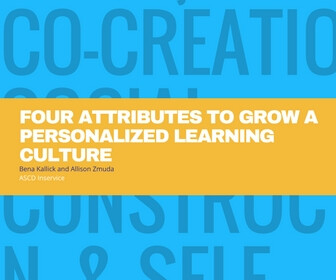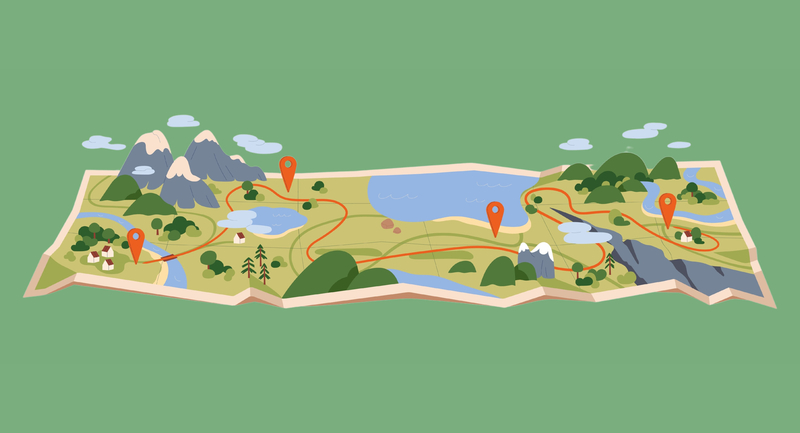The language of the culture very much reflects the feelings, behaviors, and actions that the culture values. We often live by the metaphors that we use. So, for example, when we use negative metaphor such as “in the trenches” we are signaling a combative culture. Whereas, if we use such metaphors as “inventing” or “innovating” we are bringing forward not just thoughts of survival but also thoughts of our capacity to creatively face our challenges.
As we continue to visit many schools across the country, we observe four attributes that serve as indicators a continuously growing personalized learning environment. We find that when there are opportunities for the adults as well as the students to express their voice, co-create and design, recognize the significance of socially constructing learning, and discovering who they are as learners, a beautiful culture of interdependence in thinking flourished. We also find that these cultures either intentionally or instinctively used the habits of mind that fostered deeper thinking about ideas, issues, problems to be solved.
As we consider these four attributes, new metaphors spring to mind such as a system of inventors, entrepreneurs, discoverers, gardeners. When we say we want to personalize learning, we need to create a culture that is personal, relational, and encourages each member of the school community to aspire for an environment that harvests the seeds of ideas and nurtures them to grow with an eye to the future of the entire culture as well as to the benefit of each individual.
Voice:
In a personalized learning culture, each member is seen as a respected and valued participant; they are the stewards of their own learning.
- Student empowerment comes from an environment in which students recognize the power of their own ideas and recognize the shift that can happen by being exposed to others’ ideas. Regular student participation and engagement in co-creating performances and actions constitutes an opportunity to flex their innovative and creative muscles.
- In a personalized learning culture, educators, family and community members are invited to share their perspectives on new initiatives, participate in focus groups in which they hear their own thinking as well as the thinking of others, offer new ideas to be considered. The atmosphere is one of dialogue in which multiple perspectives are encouraged. The community learns and appreciates the complexity of adhering to the values and mission of the school as an organization.
Co-creation:
We explain the act of co-creation as sitting down at the design table to imagine, strategize, and draft with classroom and school leaders as opposed to being the recipients of the final product. Co-creation is an invitational act — one that signifies respect and trust in others at the design table with you.
- Students are invited to co-create a personalized plan using “backward design” principles. The student can work with the teacher to develop a challenge, problem, or idea, clarify what is being measured (learning goals), envision the product or performance (task) and/or outline a plan to be successful on that performance so that the desired results are achieved (learning actions). Co-creation is not limited to curriculum design. They are also co-creating when, for example, they set the rules of engagement or help to design the spaces in which they work or help to develop a rubric for assessing their work.
- School/district leadership work with staff members to co-create student performances that are challenging, possible, and worthy of the attempt. Staff members assume a significant design role in the development of the idea, challenge, problem, or inquiry. The leadership team works with staff to develop a challenge, problem, or idea, clarify what is being measured (learning goals), envision the product or performance (task) and outline a plan to be successful on that performance so that the desired results are achieved (learning actions). Community is invited in to become a part of the design of innovative projects. They offer support, generate expansion of ideas, and make connections to external resources.
Social Construction:
Students and educators build ideas through relationships with others as they theorize, investigate, and develop in pursuit of a common goal. There is real power in feeling that you are not alone, a sense of camaraderie when you are working to cause a change, create a performance, or build a prototype. The synergy of individual bits of knowledge, ideas and actions that produce a bigger impact that is so much larger than that of one individual is magical.
- Social construction occurs as students seek out information, ideas, and perspectives to guide task development by consulting experts or peers who have intimate knowledge of the topic and using others as a sounding board to work through ideas or roadblocks. Students also share the results of their work— their creations, synthesis, and conclusions — to guide others, illustrate thinking, and offer perspectives.
- Educators and community members see the value of collaboration as we move forward in this journey. We reach out for expertise, realizing that we won’t know what we don’t know until we see how others interpret personalized learning. We work to define what we mean so that we share a descriptive language that helps us all remain clear and true to our goals. Including community increases the possibilities for relationships, engagement with outside resources, and deeper understanding.
Self-Discovery:
This comes about as students, teachers, and administrators uncover how they navigate through the challenges they’ve set for themselves: how they start making sense of a problem or how they generate an idea, how they handle the frustration of not getting it quite right for the umpteenth time, and how they work through revisions or dead ends by analyzing what happened. They develop the capacity to articulate areas of strength and concern and view this as a proactive opportunity to grow.
- Students come to understand themselves as learners and know more about what they want to do both in the world as well as in future learning. They reflect on the development of ideas, skill-sets, knowledge, and performances to help envision what might come next. Our ultimate aim is for students to become self-directed learners who know how to manage themselves in a variety of situations. Students need to know enough about themselves to be able to make wise decisions as they navigate through the turbulence of a rapidly changing environment.
- Educators learn more about themselves as they continuously are challenged by new ideas, technologies, and diverse student populations. The community learns alongside the educators as they discover more about themselves as much as they discover how the system adheres to its values and mission.
We are suggesting that these four attributes serve as a catalyst for attending to a culture for personalized learning. We celebrate the inclusion, equity, and respect that is demonstrated as we observe the struggle of transforming the practices that will sustain such a culture.








